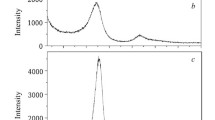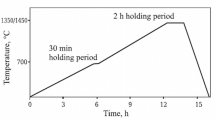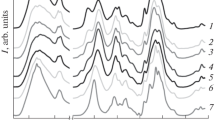The rheological properties of corundum suspensions were studied. It is shown that to prepare corundum slurry in obtaining ceramic, high-porosity, permeable, cellular materials (HPCM) by the method of duplicating the structure of polymer matrices the minimum possible ratio S : L of the disperse phase and the dispersion medium is 2.3 : 1 and the weight content of polyvinyl alcohol in the corundum slurry is 1 – 3%. It was proved experimentally that corundum suspensions with such a ratio of the disperse phase and the dispersion medium are coagulation structures with characteristic thixotropic behavior.








Similar content being viewed by others
Notes
Stresses directed along the tangent to the surface which result in shear deformation.
Viscosity under an applied load.
References
I. N. Tatarinova, Block, Highly Porous, Cellular, Palladium-Containing Catalyst for Liquid-Phase Catalysis, Author’s Abstract of Candidate’s Thesis [in Russian], RKhTU im. D. I. Mendeleeva, Moscow (2008),
V. N. Grunskii, Small-Volume Block Catalytic Systems with Cellular Structure with an Extended Regulated External Surface, Author’s Abstract of Doctoral’s Thesis [in Russian], RKhTU im. D. I. Mendeleeva, Moscow (2009).
V. N. Antsiferov, A. M. Beklemishev, V. G. Gilev, et al., Problems of Powder Materials Science. Part II. Highly Porous Permeable Materials [in Russian], UrO RAN, Ekaterinburg (2002).
V. N. Antsiferov and S. E. Porozova, Highly Porous Permeable Materials Based on Aluminosilicates [in Russian], Perm State Technical University, Perm (1996).
V. N. Antsiferov, A. M. Makarov, and S. E. Porozova, “On the use of catalysts based on highly porous ceramic materials,” Zh. Prikl Khim., 66(2), 449 – 451 (1993).
V. N. Grunskii, A. V. Bespalov, M. D. Gasparyan, et al., “Frame and structural characteristics of highly porous, permeable, cellular, ceramic materials using a slip based on aluminosilicate binders,” Ogneup. Tekh. Keram., Nos. 4 – 5, 8 – 12 (2012).
V. N. Grunskii, A. V. Bespalov,M. D. Gasparyan, et al., “Highly porous permeable cellular ceramic materials using a slip based on aluminosilicate binders,” Ogneup. Tekh. Keram., Nos. 4 – 5, 45 – 48 (2012).
V. V. Ignatenkova, A. V. Bespalov, V. N. Grunskii, and I. A. Belova, “Rheological Properties of the corundum slip for the production of cellular materials,” Khim. Prom.-st’Segodnya, No. 1, 13 – 17 (2011).
V. V. Nazarov, A. S. Grodskii, A. F. Morgunov, et al., Practical Work and Problem Book on Colloid Chemistry. Surface Phenomena and Disperse Systems [in Russian], Akademkniga, Moscow (2007).
L. M. Trufakina and E. G. Kudeshova, “Rheological properties of mixtures of semi-diluted and concentrated solutions of polyvinyl alcohol and carboxymethylcellulose,” Inzh.-Fiz. Zh., 76(3), 55 – 58 (2003).
Yu. G. Frolov, A Course in Colloid Chemistry. Surface Phenomena and Disperse Systems [in Russian], TID ‘Al’yans,’ Moscow (2009).
G. Schramm, Fundamentals of Practical Rheology and Rheometry [Russian translation], KolosS, Moscow (2003).
Author information
Authors and Affiliations
Corresponding author
Additional information
Translated from Steklo i Keramika, No. 4, pp. 15 – 21, April, 2019.
Rights and permissions
About this article
Cite this article
Bespalov, A.V., Grunskii, V.N., Makarov, N.A. et al. Improvement of the Technology of High-Porosity, Permeable, Cellular, Ceramic Materials. Glass Ceram 76, 131–136 (2019). https://doi.org/10.1007/s10717-019-00149-8
Published:
Issue Date:
DOI: https://doi.org/10.1007/s10717-019-00149-8




